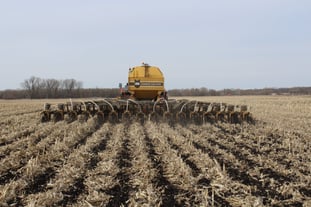Kevin’s Keen Eye for Fall Strip-Till
Kevin Kuehn is no stranger to the SoilWarrior. He is a sixteen-year veteran in service and product support with ETS. Kevin brings a passion for agriculture and a drive for defending the land and leading the charge to his current role as a regional sales manager every day. That passion has given him a keen eye when it comes to strip-tilling with the SoilWarrior. Here are Kevin’s secrets to a successful fall strip-till season.
While many view this fall season as a time to recap the past growing season, Kevin encourages growers to be thinking about next year. Fall strip tilling is often the first field operation done in preparation for next year’s crop.
“Before a grower begins his fall strip tilling, they need to think about the next spring and the plan for each field and the crop that will be planted,” said Kevin. “Work with a local agronomist or crop consultant and make your fertilizer  recommendations before you even begin harvest. Having that done will be one less thing that needs to happen in season.”
recommendations before you even begin harvest. Having that done will be one less thing that needs to happen in season.”
Strip tillage and fertilizer application with the SoilWarrior is a complete system. Kevin recommends that all operators keep these five things in mind as they begin applying dry fertilizer.
- The SoilWarrior can apply dry and liquid product across a wide range of rates. As low as 25 pounds to over 400 pounds per acre per dry bin. Meter roll size and travel speed affects the application rate. Just remember as the rates go higher, ground speed may be affected.
- Be cautious about using liquid additives with dry fertilizers. In some cases, the additive may build up on meter rolls or in the hoses. If an additive is desired, use the driest form of the additive available.
- Think about how you want your fertilizer applied. ETS offers a fan diffuser fertilizer placement tube. The fan diffuser has a lower assembly that spreads the fertilizer the width of the entire zone between the containment coulters.
- Seeing some fertilizer on top of the strips is normal.
- Calibrate your SoilWarrior scale(s). The calibration procedure is in the Operators Manual.
As fertilizer is being applied, an operator also needs to monitor berm height. “Berm height is in direct relationship to the amount of air within the tilled zone – specifically spaces between soil particles. Making sure your containment coulters are set correctly is an easy way to adjust your berm height,” said Kevin. “Not to worry, the containment coulters are adjustable for different soil types and conditions to allow you to set them to your liking.” Kevin also wants to remind operators that Mother Nature will change the zones prior to planting; do not forget to check the zones before planting.
Before any of these items can start, a grower needs to make sure the combine is set correctly to help make beautiful fall strips. Residue incorporation is something that the SoilWarrior is known for doing well, and the SoilWarrior does not shy away from corn on corn! “With strip-till the true start of seed bed preparation starts with the combine,” said Kevin. Remember these two simple steps when operating the combine.
- Stalk management. When deciding how to manage your stalks, consider flow between your strip-till row units.
- Set your combine residue management system for an even spread, which contributes to consistent strips and allows the soil to warm up more evenly in the spring.
 Lastly, as nighttime temperatures start to dip below the freezing mark, take these actions for optimal SoilWarrior performance and care. Drain your air compressor several times a day to reduce moisture buildup in the air system. Consider putting some airline anti-freeze in the air tank to keep any accumulated fluid from freezing. Any antifreeze used will have to be replaced after each time the system is drained. For liquid fertilizer systems, pay particular attention to nighttime temperature. Drain the system completely (if possible). The VisiGage system needs to be drained for sure. If a SoilWarrior has a nitrification inhibitor injector system on board, that must be emptied and thoroughly rinsed to avoid crystallization at low temperatures.
Lastly, as nighttime temperatures start to dip below the freezing mark, take these actions for optimal SoilWarrior performance and care. Drain your air compressor several times a day to reduce moisture buildup in the air system. Consider putting some airline anti-freeze in the air tank to keep any accumulated fluid from freezing. Any antifreeze used will have to be replaced after each time the system is drained. For liquid fertilizer systems, pay particular attention to nighttime temperature. Drain the system completely (if possible). The VisiGage system needs to be drained for sure. If a SoilWarrior has a nitrification inhibitor injector system on board, that must be emptied and thoroughly rinsed to avoid crystallization at low temperatures.
All these tips still apply in the spring - if fall strip-till does not work for your operation or you prefer spring-only strip-till or fall weather pushes your strip tilling to spring. ETS prides themselves in being strip-till experts. If you have questions before you start or while you are in the field, we are here for you.
Want to see what SoilWarrior strips look like in your field?

Comment